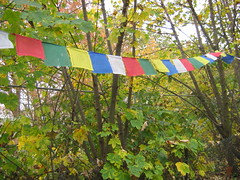Please make sure you have colors with you on Thurs. After the quizzes we will make paper Tibetan Buddhist flags.
A prayer flag is a colorful panel or rectangular cloth often found strung along mountain ridges and peaks high in the Himalayas to bless the surrounding countryside or for other purposes, says Wikipedia.
There are two kinds of prayer flags: horizontal ones, called lung ta (meaning "Wind Horse") in Tibetan, and the vertical Darchor. "Dar" translates as "to increase life, fortune, health and wealth", "Cho" translates as "all sentient beings".[1]
Traditionally, prayer flags are used to promote peace, compassion, strength, and wisdom. The flags do not carry prayers to 'gods,' a common misconception; rather, the Tibetans believe the prayers and mantras will be blown by the wind to spread the good will and compassion into all pervading space. Therefore, prayer flags are thought to bring benefit to all.
Lung Ta (horizontal) prayer flags are of square or rectangular shape and are connected along their top edges to a long string or thread. They are commonly hung on a diagonal line from high to low between two objects (e.g., a rock and the top of a pole) in high places such as the tops of temples, monasteries, stupas or mountain passes.
Traditionally, prayer flags come in sets of five, one in each of five colors. The five colors represent the elements,[1] and the Five Pure Lights and are arranged from left to right in a specific order. Different elements are associated with different colors for specific traditions, purposes and sadhana:
* Blue (symbolizing sky/space)
* White (symbolizing air/wind)
* Red (symbolizing fire)
* Green (symbolizing water)
* Yellow (symbolizing earth)[1]
The center of a prayer flag traditionally features a "Ta" (powerful or strong horse) bearing three flaming jewels (specifically ratna) on its back. The Ta is a symbol of speed and the transformation of bad fortune to good fortune. The three flaming jewels symbolize the Buddha, the Dharma (Buddhist teachings), and the Sangha (Buddhist community), the three cornerstones of Tibetan philosophical tradition.
Surrounding the Ta are various versions of approximately 400 traditional mantras (powerful ritual utterances).
skip to main |
skip to sidebar
For students and parents who love education and exploration of the social sciences . . .
Search This Blog
Followers
Blog Archive
-
▼
2010
(346)
-
▼
April
(32)
- Hard Working Substitute Wei: "Not One Less" Wei Essay
- A quiz on the Odyssey of a Chinese Teen in Not One...
- Grab some chopsticks and bring them to class on Tues
- This weekend: Artbreak, Night of One-Acts, Relay f...
- Drop outs often find their way into the criminal j...
- Not One Less quiz on Thurs: see previous questions...
- Constructed response to the list of Japanese compa...
- Making Tibetan Buddhist flags in geography class o...
- The NY Times describes 36 hours in Kyoto, the impe...
- Product placement in Not One Less: Coca-Cola China
- Thurs reading comprehension quiz on Not One Less a...
- Vietnam vet interview: 15 pts / Book report: 20 pts
- The First Emperor Quiz
- Not One Less created by one of China's most succes...
- Final exam schedule May 25 - 27, 2010
- Wei Minzhi in Zhang Yimou's movie Not One Less
- Bonus credit for attending Shakespeare in the Cent...
- Week of Ap 18: Quiz on Wed and presentation on Fri...
- Mapping Magnet High and the area
- Alchemists and mercury
- Creating a dramatic presentation on the Middle Kin...
- Chinese tombs and embalming
- Map quiz followed by giant paper Chinese Mask maki...
- iLeap & GEE tests Mon - Wed, April 12 14, 8:30 am ...
- Bonus credit: attend the Magnet Choir's performanc...
- Qin Shi Huangdi review: the First Emperor and his ...
- Which would you rather carry to school: a laptop a...
- Indie work on China
- Chinese history via research and skits
- Chine 中国 - Shanghaï 上海
- Coming to the RFC: The Films of Ang Lee, April 5-9
- Domino theory and a gorilla in the living room: th...
-
▼
April
(32)

